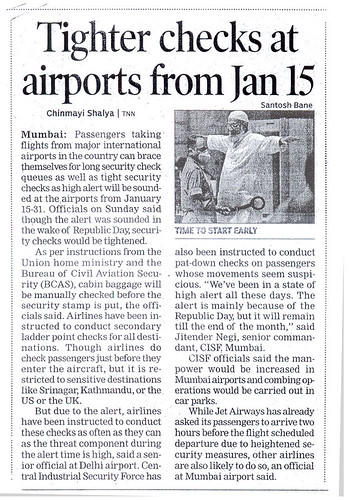By Md. Ali, TwoCircles.net,
While skeletons of terrorists are tumbling out of RSS cupboard as Hindu extremists are being found involved in various terror blasts–Malegaon, Ajmer, Hyderabad and Samjhauta Express to name a few – the stereotype that only Muslims are or potential terrorists remains unchanged both in police and media.
Coming on the heels of Tamil Nadu police’s mock counterterrorism drill with characters wearing Muslim look last month evoking protest from Tamil Nadu Muslim Munnetra Kazagham, Times of India last week carried a news item on intensified security checks at airports in the country in run-up to the Republic Day on 26th January – the news item had a picture of bearded, skull-capped Muslim elderly person being manually checked by security. The news piece datelined Mumbai ran under the heading “Tighter checks at airports from Jan 15” on 3rd January. The accompanying picture had the caption: Time to Start Early.

Times of India January 3
Does a terrorist look like this bearded man only? Are there no other terrorists? Media or at least a large section of it which earlier swallowed whole police stories after every terror blasts seems unperturbed with the latest answers to these two questions.
While there is nothing problematic in the report, anybody having sanity should worry about the kind of picture which accompanied the TOI report. While the report essentially conveyed the message of heightened security measures, the picture shamelessly reminded the same reader – public and security personnel as well as agencies– about the identity of potential terrorists.
The selection of that picture for this particular story is problematic because somewhere or the other it evokes the stereotype of Muslims as terrorists. Otherwise why was it that only that picture of apparently a Muslim being checked was used when any picture could have served the purpose? Should not the photo editor or the editor of the page been a bit cautious and sensitive while selecting that photo?
The other side of the argument is that why so much of hue and cry when it’s just a picture; after all never does the report mention anything about Muslims and their alleged monopoly over the domain of terror.
True it is just a photo but what is essentially problematic is the kind of stereotype it intentionally or unintentionally evokes; particularly when a newspaper like TOI with readership of millions carries that story. It goes against journalistic ethics also because by using this kind of picture the newspaper seems to be endorsing and reinforcing the typecast that Muslims are terrorists.
It is no one’s argument that instead of the picture of a Muslim, photo of a person donning saffron clothes (read Hindutva terrorist) should have been used because Aseemanand’s confession ( to use a recent example) proves that terror blasts in the country have been executed by Hindutva terrorists also. But that again will be amount to evoking another stereotype and I strongly believe that a stereotype can’t be countered by another stereotype. Any sane person would say why evoke stereotype at all when any picture will do.
Now, the question is: Why does media take recourse to stereotype at all in the first place?
In most of the cases media takes recourse to stereotypes because it sells because at various psychological levels, people want that. But Dr. Shanker Dutt, professor of Patna University believes that media evokes famous stereotypes because it is easy even though, in the process, their credibility and impartiality become the casualty.

